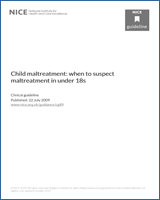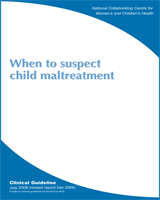The term apparent life-threatening event (ALTE) was introduced in 1986 by the National Institutes of Health Consensus Development Conference on Infantile Apnea and Home Monitoring.41 The term ALTE was introduced to replace other terms such as ‘near-miss SIDS’ or ‘aborted cot death’ that misled people into thinking that there was a direct association between these symptoms and sudden infant death syndrome (SIDS). The consensus conference defined ALTE as being a combination of the following symptoms:
This review examines the evidence linking ALTEs with maltreatment.
Narrative summary
One systematic review (eight papers; search undertaken in 2002) assessed the initial diagnosis given when infants presented with an ALTE.42 The review included eight studies involving 643 infants seen in emergency departments or paediatric units. The study calculated that 0.6% to 0.8% of emergency admissions for infants were for ALTE. A total of 728 diagnoses covering 50 conditions were reported, of which 227 were gastro-oesophageal reflux disease (GORD), 169 were unknown, 83 were seizures, 58 were lower respiratory tract infection, 26 were ear, nose and throat (ENT) problems, 17 were breath-holding, 11 were metabolic disease, 11 were ingestion of toxins or drugs, eight were urinary tract infection (UTIs), six were cardiac problems, five were benign cause, and two were fabricated illness (0.3% of children). The study concluded that careful investigation of ALTE is needed because of many possible causes. [EL = 2+]
A prospective cohort study (n = 44184) undertaken in Austria investigated the epidemiology of ALTE.43 The study identified 164 cases of ALTE, or 2.46 per 1000 live births. An underlying cause was identified in 91 of 164 cases (55%): 29% were respiratory, 22% were digestive (gastrointestinal) tract, 2% were congenital cardiac malformation, 1% were inborn metabolic errors and 1% were convulsions. The study made no conclusions in relation to child maltreatment. [EL = 3]
A prospective cohort study (n = 340) undertaken in Australia examined the diagnosis of ALTEs: 289 of 340 had a diagnosis of which 211 were GORD, 17 were airway pathology, 25 were fits/seizures, two were brain-stem tumours, two were hypoglycaemia, eight were respiratory syncytial virus, five were fabricated or induced illness (FII) (1.7% of those diagnosed, 1.5% of total) and 27 were abnormal pneumograms (11 with reflux).44 Fifty-one had no abnormal finding. The study made no conclusions in relation to child maltreatment. [EL = 3]
A prospective case series (n = 128) from the USA of children younger than 24 months presenting at a single emergency department examined the diagnosis applied to cases of ALTE.45 Of the 128 cases of ALTE, 51 were GORD, 38 were apnoea, 11 were choking episode, six were infection, five were bronchiolitis, five were upper respiratory infection, four were seizures, three were abuse (2.3% of total), three were swallowing disorder and two were breathing-holding spell. The study concluded that abuse was diagnosed in 2.3% of cases of ALTE and this should be considered in patients who present with ALTE. [EL = 3]
A prospective case series (n = 157) from the UK of children (aged 1 week to 96 months) presenting once or more in one hospital setting examined the diagnosis applied to cases of ALTE.46 The study reported that, of the 157 reported cases, 80 had no diagnosis. Of those diagnosed, two had disturbances in skin perfusion, seven had fabricated illness (9% of those diagnosed and 4% of the total), 18 had suffered suffocation (23% of those diagnosed and 11.5% of the total), 40 had hypoxaemic events with no evidence of suffocation or epilepsy, and ten had hypoxaemia induced by epilepsy. The study concluded that identification of mechanisms is essential to the appropriate management of infants with ALTEs. [EL = 3]
A prospective case series (n = 243) of infants younger than 12 months admitted to one tertiary unit in the USA examined the diagnosis given to cases of ALTE.47 The study found 35 different causes for ALTE. Of the total cases, 80 were caused by infection, 69 were gastrointestinal, 32 were neurological including six (2.5% of total) abusive head injuries within this group, seven were airway obstruction, six were congenital or birth-related problems, 39 had an unknown cause, three were breath-holding spells, two were periodic breathing and one was vasovagal response. The study concluded that a wide spectrum of diseases and disorders can precipitate an ALTE. In relation to maltreatment, the study concluded that ‘Among them, abusive head injury, a recently recognized cause, occurs frequently enough to obligate its inclusion in the differential diagnosis.’ [EL = 3]
A retrospective case series (n = 60) from the USA examined the diagnosis applied to infants with ALTE.48 The study setting was a single emergency medical service (EMS) over a 12 month period. The study found that 60 (7.5%) of 804 infants encountered met the criteria for ALTE (absence of breath, colour change, change in muscle tone). The diagnoses applied to these cases were: 20 (33%) had no diagnosis, seven (12%) were pneumonia or bronchiolitis, six (10%) were GORD, five (8%) were seizures, four (7%) were sepsis, four (7%) were upper respiratory infection, three (5%) were apnoea episodes, two (3%) were intracranial haemorrhage, two (3%) left against advice, one (2%) was bacterial meningitis, one (2%) was dehydration and one (2%) was severe anaemia. Furthermore, 35% of the 60 infants had been diagnosed with underlying conditions. The study reported one case of intracranial injury caused by maltreatment, but highlighted that in 20 cases no diagnosis was made and in two cases the parents left against medical advice. The study concluded that ‘An apparent life-threatening event in an infant can present without signs of acute illness and is commonly encountered in the EMS setting. It is often associated with significant medical conditions, and EMS personnel should be aware of the clinical importance of an apparent life-threatening event. Infants meeting criteria for an apparent life-threatening event should receive a timely and thorough medical evaluation.’ [EL = 3]
A retrospective case series (n = 73) of infants (mean age 7.4 weeks) who were seen at a single apnoea programme in the USA reported that 47 infants had negative investigation, 17 had recurrent events but no diagnosis, five had respiratory infection, two had GORD, one had pallid syncope and one had tracheal stenosis.49 [EL = 3]
A retrospective partially controlled case study (n = 85) from the UK compared the medical and family history of maltreated children (30 of 39 children with maltreatment confirmed by covert videoing) and non-maltreated children (46 children with confirmed respiratory disease or epilepsy) presenting with ALTE.50 The mean age of maltreated children when they first presented with ALTE was 3.6 months. The study found that in the 41 siblings of the maltreatment group there were 12 unexpected deaths compared with one unexpected death among the 52 siblings of the control group (P < 0.0001). [EL = 2−]
A survey of 11 apnoea monitoring programmes and four apnoea monitoring device vendors in the USA examined reports of infant deaths.51 Over a 5 year period, 1841 children were monitored. There were 25 reported deaths in this group: 13 due to SIDS, four due to non-accidental trauma (0.2% of total), six due to sudden unexpected death at home, one due to subarachnoid haemorrhage and one caused by cardiac disease. The study reported no specific conclusions relating to maltreatment. [EL = 3]
A retrospective case series (n = 28) from the USA of children who suffered proven non-accidental head injury examined their presentation and outcome.52 Of the children examined, only three were aged I year or over. The results showed that 16 of 28 presented with apnoea. Of those who presented with apnoea, 57% had a history of apnoea and 71% had previous seizures within 24 hours. The study found that 12 were left with severe disability, four died, one was in a vegetative state and seven survived. The authors concluded that trauma-induced apnoea is more important to outcome than the mechanism of injury. [EL = 3]
A survey of 51 of 127 (n = 20 090) apnoea monitoring programmes in the USA investigated the prevalence of FII. The results showed that 54 (0.25% of total) cases of FII were reported. The mean age of infants with this diagnosis was 8.2 weeks. Detailed information on 32 of these cases showed that 18 were re-hospitalised between one and four times, 13 were re-hospitalised five or more times and one was unknown. The study concluded that FII presents as unexplained multiple, serious apnoea events occurring in the presence of only one person (not witnessed).53 [EL = 3]
Nasal bleeding
A systematic review of nasal bleeding in deliberate suffocation was identified. Studies that were found in the literature search often reported post-mortem findings; this is beyond the scope of the guidance.
A systematic review of associations between nasal bleeding and deliberate suffocation in infants identified six studies that reported on facial bleeding, of which it appears that four are of children who were dead on presentation.54 A case–control study of ALTEs found nine deliberate suffocation patients with nasal bleeding (n = 30) and no children with nasal bleeding in the group suffering ALTE from medical causes (n = 46). A case series of children with recurrent ALTE reported 12 of 138 children with facial bleeding. [EL = 2+]


